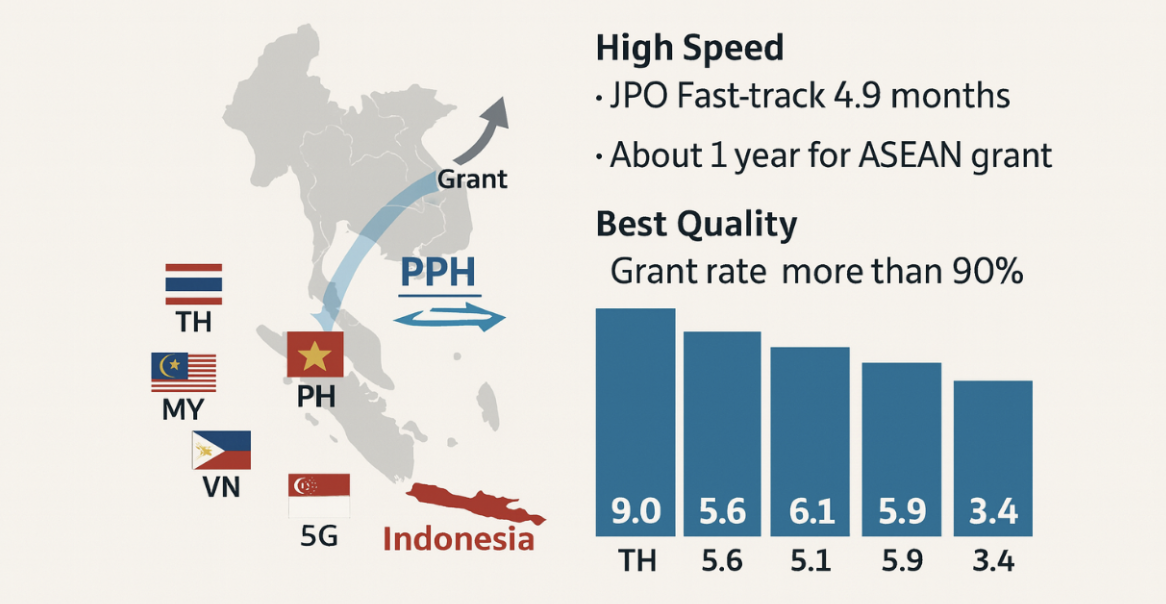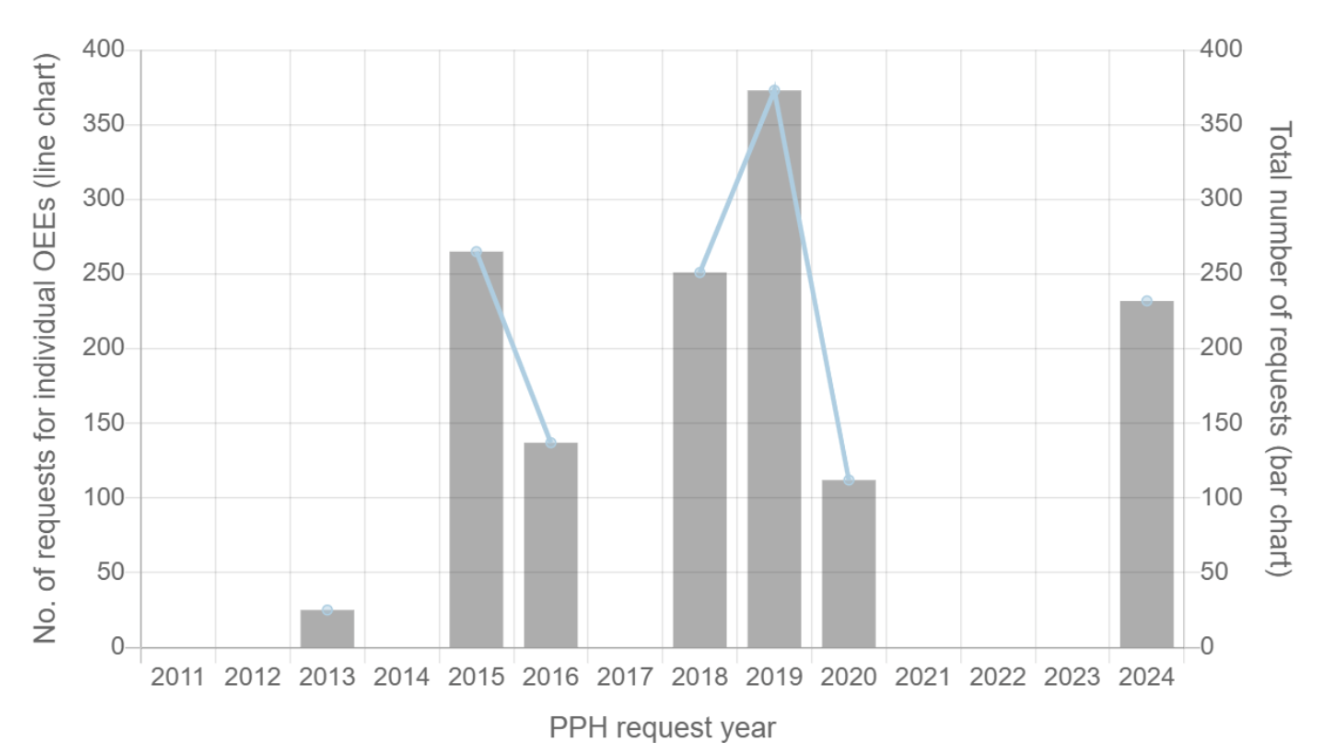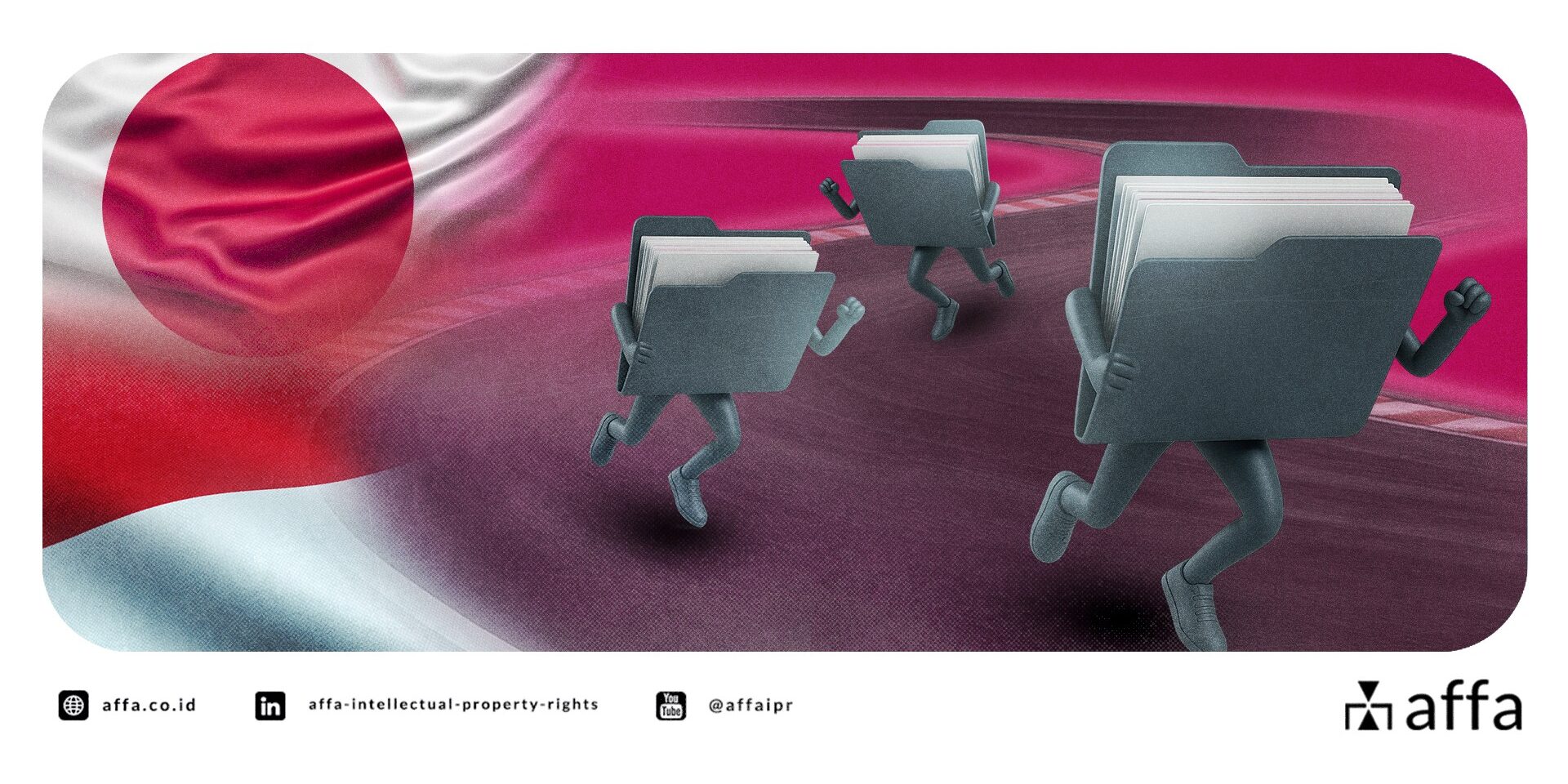In the race for innovation, speed is everything. According to statistical data published by the Japan Patent Office (JPO), among the ASEAN6 Patent Offices (the six ASEAN countries with the highest Patent rankings), the Directorate General of Intellectual Property of Indonesia (DGIP) is recorded as the office with the shortest total pendency—meaning the duration from filing to grant—at only around 3.4 years. In contrast, other ASEAN Patent Offices generally remain in the range of 4.5 to 7 years. This figure aligns with Indonesia’s ongoing efforts to accelerate examination, including through the utilization of the Patent Prosecution Highway (PPH) scheme.
What is even more interesting is that, as the only office implementing PPH with all ASEAN6 Patent Offices, the JPO serves as a strategic gateway for Applicants seeking protection across the ASEAN region. The JPO reports the following statistics:
- The time to obtain a patent grant in Japan through the fast-track route can be achieved in approximately 4.9 months; and
- Patent grants in ASEAN Offices through the PPH scheme can be achieved in around 1 year, with grant rates exceeding 90%.

In addition to illustrating examination performance, JPO’s data also shows that the PPH route with DGIP as the Office of Later Examination (OLE) has been actively utilized by international Applicants. Since the program’s initiation in 2013, the number of PPH requests designating DGIP as the OLE has consistently remained in the hundreds per year, reaching a peak in 2019. Although the numbers later declined, they have re-emerged significantly in 2024. This indicates that the DGIP–JPO PPH scheme is not merely a procedural option on paper, but a pathway genuinely used by global businesses when entering the Indonesian and ASEAN markets.
Given this background and the fact that DGIP records the fastest total pendency among the ASEAN6, Applicants can structure the following two-step strategy:
- Designate Japan as the primary examination hub, either as the first filing country or as the International Searching Authority (ISA/JP) under the Patent Cooperation Treaty (PCT); and
- Utilize the PPH scheme for accelerated access to ASEAN, with Indonesia as a key destination given its comparatively shorter time to grant.
This combination creates a highly compelling narrative for businesses and technology owners. The JPO provides fast and high-quality examination at the “upstream” stage, while DGIP offers one of the fastest routes to grant in the “downstream” ASEAN region. For companies that view ASEAN as a growth market, this combination can significantly reduce risks and shorten timelines in the patent application process.

Number of PPH requests with DGIP as the Office of Later Examination (OLE) per PPH application year.
Source: Japan Patent Office (JPO), “PPH Statistics.”
How Does the DGIP–JPO PPH Actually Work?
In simple terms, the PPH is a cooperative framework between Patent Offices that allows one Office to rely on the search and examination results produced by another. In essence, patent examination under the PPH can be accelerated at DGIP by leveraging the examination work products issued by the JPO.
Institutionally, the DGIP–JPO PPH scheme did not emerge overnight. The trial phase of the DGIP–JPO PPH program was first launched in 2013 as an effort to test the use of JPO examination results to expedite the process in Indonesia. As utilization increased and positive responses were received from Applicants, the cooperation was extended multiple times. Under the latest agreement, the DGIP–JPO PPH program has been renewed once again and will continue until 2026. These periodic extensions indicate that the PPH is considered successful by both Offices—reducing examination burdens on one side while providing a stable acceleration route for Applicants on the other.
According to DGIP’s official guidelines, the DGIP–JPO PPH scheme is divided into two categories:
1. PPH Based on JPO National Work Products
Under this scheme, a PPH request is filed for a patent application that has already entered DGIP, by referring to its corresponding application at the JPO. The main requirements for filing a PPH request under this scheme include:
- The application at DGIP and the corresponding application at the JPO that forms the basis of the PPH must share the same earliest date (whether a priority date or filing date), either through the Paris Route or the PCT Route.
- The earliest application in the patent family must have been filed at either DGIP or the JPO as a national office.
- At least one JPO application must have claims that have been determined to be patentable/allowable, as reflected in a Decision to Grant, Notification of Reasons for Refusal, Decision of Refusal, or Appeal Decision.
- All claims submitted for examination under the PPH at DGIP must “sufficiently correspond” to the claims considered patentable/allowable at the JPO—that is, the claim scope must be identical, similar, or narrower through the addition of limiting features supported by the specification.
- A PPH request can only be made if DGIP has not yet begun substantive examination of the application.
2. PCT-PPH Based on PCT International Work Products (WO/ISA, WO/IPEA, IPER)
In this scheme, in addition to national work products, the guidelines also provide for PCT-PPH. Here, the basis for acceleration is no longer the JPO’s national office actions but the JPO’s international work products in its capacity as:
- WO/ISA – Written Opinion of the International Searching Authority
- WO/IPEA – Written Opinion of the International Preliminary Examining Authority
- IPER – International Preliminary Examination Report
The main requirements include:
- The latest International Work Product must indicate that at least one claim is patentable/allowable with respect to novelty, inventive step, and industrial applicability.
- The DGIP application and the corresponding PCT international application must share the same earliest date (whether through national phase entry, priority basis, or as a derivative/divisional).
- All claims filed at DGIP must “sufficiently correspond” to the claims considered patentable/allowable in the relevant International Work Product.
PPH MOTTAINAI
Beyond the two main pathways above, the JPO has also introduced the concept of PPH MOTTAINAI. In simple terms, “mottainai” in Japanese conveys a sense of regret when something valuable is wasted.
In the context of PPH, this idea is translated into the principle of “ensuring that existing examination results do not go to waste.” In the classical PPH scheme, the “Office of Earlier Examination” is typically the office where the application was first filed. Under PPH MOTTAINAI, however, whichever office issues a positive examination result first—regardless of where the first filing occurred—may serve as the basis for a PPH request at another office.
Through this approach, Applicants can continue to make use of existing work products—whether National Work Products or PCT International Work Products—without being constrained by the order of the initial filings. Although its technical implementation depends on each office’s procedures, the MOTTAINAI concept reflects a shared policy direction: that high-quality examination results should be maximized, not repeated from scratch.
Filing Window That Must Be Carefully Observed
DGIP emphasizes that a PPH request must be filed before substantive examination begins (and only after the application has been published and the opposition period has ended). This requirement is not always explicitly imposed by all Patent Offices, but it is a distinctive feature of DGIP. On the JPO side, a PPH request must also be filed before examination at the JPO begins—making the practical rule the same: “submit as early as possible.”
Ultimately, the statistics from the JPO and the procedural framework set out in the official guidelines point to the same conclusion: the DGIP–JPO PPH is a serious, structured, and increasingly relevant pathway for Applicants seeking to secure patent rights in Indonesia and the ASEAN region. From a policy standpoint, the program’s extension through 2026 reflects both Offices’ confidence in the effectiveness of the scheme. From a practical standpoint, the consistent number of PPH requests with DGIP as the OLE indicates that global businesses have already incorporated it into their portfolio strategies. In an era of intensifying technological competition and heightened counterfeiting risks, leveraging the PPH is no longer merely an optional add-on but a time- and risk-management tool that deserves consideration from the earliest stages of patent family planning.
For companies, universities, and research institutions targeting Indonesia as one of their key Asian markets, the next step is to ensure that filing strategies, claim drafting, and pathway selection (national route, PCT-PPH, or MOTTAINAI) are carefully structured to meet all DGIP–JPO PPH requirements. Assistance from a Patent Consultant who understands examination practices at both JPO and DGIP will be highly valuable in mapping patent families, preparing claim correspondence tables, and optimizing the PPH filing window. With the right planning and strategic use of the PPH, Applicants can obtain patent protection that is faster, more predictable, and better aligned with their technology commercialization goals in Indonesia.
Should you need more information on the DGIP–JPO Patent Prosecution Highway, contact us through the channels below and get a FREE 15-minute consultation!
📩 E-Mail : [email protected]
📞 Book a Call : +62 21 83793812
💬 WhatsApp : +62 812 87000 889







